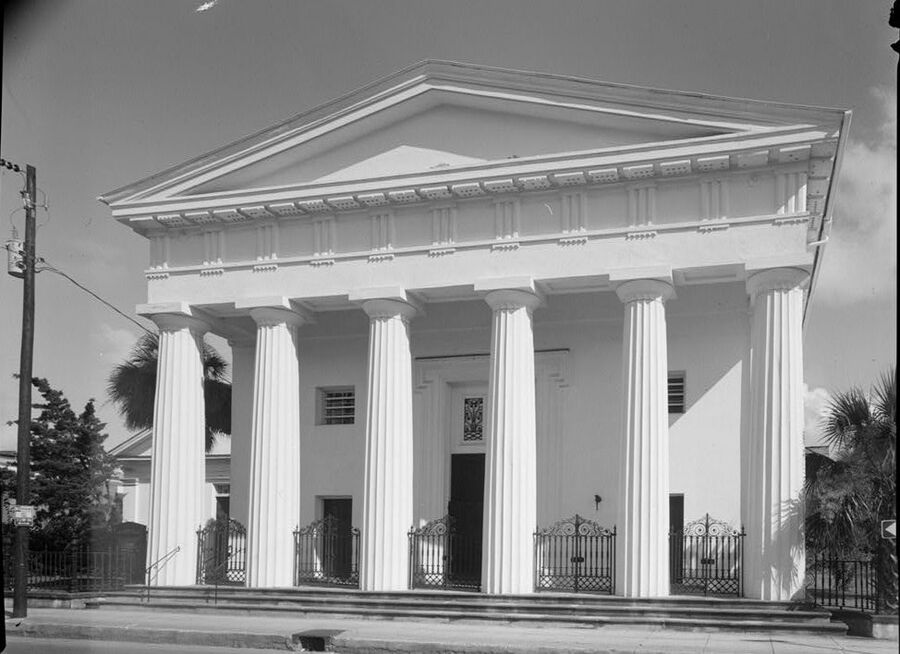Centenary United Methodist Church, 60 Wentworth

Charleston has one of the longest and richest histories of Black church communities in the United States. The church has served as a rallying point for the Black community―before and after emancipation―to organize for political, social, and economic uplift.
Charleston has one of the longest and richest histories of Black church communities in the United States. The church has served as a rallying point for the Black community―before and after emancipation―to organize for political, social, and economic uplift. During the antebellum years, Black church communities rarely had physical spaces to worship, and Black Christians were often forced to attend and operate as second-class members of white churches. Postbellum, Black church communities began splitting from their former white congregations and acquiring buildings to lead their own church congregations. Black church communities worked together to build structures, buy older churches, or repurpose buildings to use for worship spaces.
Centenary United Methodist Church’s congregation was organized circa 1862. Its founding members were free people of color who worshiped at Trinity Methodist Church in Charleston. Early members of the Centenary United Methodist Church community were forced to worship in buildings like the Military Hall on Wentworth Street, the gallery of Old Trinity Methodist Church, and in the Normal School building, also known as the Memminger School, on Beaufain and St. Phillips streets. Due to the racist discrimination and ordinances of the time, Black congregations had difficulty finding church homes in which they could worship.
At the time of Centenary’s inception, most white Charlestonians had fled because of the tumultuous war, resulting in a lack of Methodist Episcopal Church leaders. As a result, Union Army officials gave authority of Methodist churches to Reverend Theodore Willard Lewis. Reverend Lewis, from Massachusetts, along with Reverend Alonzo Webster, from Vermont, began organizing Black congregations in Charleston.
In 1865, Webster was officially appointed as leader to organize the congregation of Black Methodists who had withdrawn from Trinity Baptist Church. Reverend Webster led the congregation during their transition at Memminger Normal School. They rallied support from the Missionary Society, who helped provide funding to purchase the building for their new church home.
The building, a classical Greek style brick structure designed by Edwin Brickle White, was erected in 1842. Before the Centenary United Methodist Church congregation moved in, it was the home of Wentworth Street Baptist Church, formerly known as Second Baptist Church. Due to the racist social customs of the time, the Centenary Methodist Church community faced unique challenges in acquiring this building. When the Wentworth Street Baptist offered the church building up for sale, the only form of payment that they would accept was gold. The Centenary Methodist Church paid $20,000 in gold on April 10, 1866. Some of the gold had to be shipped from New York because there was not enough gold available in Charleston at the time.
Centenary United Methodist Church grew to be a sacred space for political organizing and social uplift amongst Black Charlestonians. Using this space, community leaders from different religious, social, and political backgrounds cooperated to solve some of the issues the Black community faced. For example, on June 2, 1883, Centenary United Methodist Church’s building served as the venue of a meeting amongst leaders to discuss the guidance of Avery Normal School, which at that time, was the premiere educational institution for Charleston’s Black community. At this meeting, they crafted a memorandum to the American Missionary Association, Avery Normal Institute’s main patron, pushing for the school to “meet the conditions and wants of the Charleston community,” by upgrading its curriculum to accommodate for the growing affluent class of Black Charlestonians in the post-bellum period.
In the spring of 1916, the church was used to organize the Charleston City Federation, a smaller arm of the National Federation of Colored Women’s Clubs. Jeanette Cox, the wife of Avery Normal Institute’s principal, Benjamin Cox, and founder of the Phillis Wheatley Literary and Social Club, was elected as the first delegate to the annual conference of the state federation.
Centenary United Methodist grew to be one of the favorite churches of Charleston’s Black upper class. It was unique from other Black Methodist churches in the late 19th century because most of its congregation lived in Charleston proper, and were free persons of color before the Civil War. Many were at the forefront of the social, political, and economic struggles for freedom in Charleston. The physical structure of Centenary served as a safe space for generations, despite having been through several challenges. On August 27, 1911, the building was damaged by a hurricane. In 1953, the interior was renovated and in 1964, extensive repairs and renovations to the exterior of the building took place. Despite these challenges, the church still stands as a symbol of resistance in Charleston and the Lowcountry.
Images
